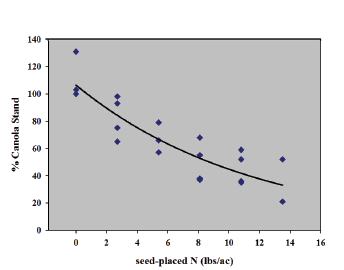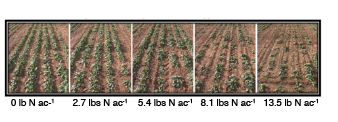Starter Fertilizer for Winter Canola in Oklahoma
Many producers in Oklahoma could benefit by using starter fertilizer when planting winter canola. Starter fertilizer is a small amount of fertilizer nutrients applied in close proximity to the seed at planting. In some soil environments, a seedling root system lacks the size and density to be able to intercept the necessary nutrients within the soil. Starter fertilizers enhance the development of emerging seedlings by placing a readily available supply of nutrients where the undeveloped root system of the seedling can access easily. Starter fertilizers are formulated as liquid or granule mixtures, which contain nutrients that are deficient in the soil and/or limited because of cold soil temperatures. Nitrogen (N), phosphorus (P), potassium (K) and additional nutrients such as zinc (Zn) and sulfur (S) are common nutrients found in starter fertilizers.
Nitrogen and phosphorus are the key components in a starter fertilizer. Phosphorus is important for promoting vigorous root growth; however, it is immobile in the soil. To be absorbed by the plant, the roots must be very close to the phosphate. Hence, phosphorus should be strategically placed close to the seed to obtain an early growth boost. Nitrogen, on the other hand, is a mobile nutrient. Therefore, placement may not be as critical as phosphorus, but nitrogen in the starter fertilizer may help avoid early season nitrogen deficiency due to the slow release of nitrogen in organic matter, particularly during cold conditions.
Starter Fertilizer Sources
Soil testing provides the information needed to decide the proper ratio of nutrients required to get the plant off to a good start. Generally, any fertilizer that contains at least nitrogen and phosphorus will work as a starter. For enhanced phosphorus uptake, phosphate should be combined with ammonium nitrogen. On soils with high phosphorus content, a nitrogen-only starter will usually provide adequate response without adding extra phosphorus. Many different fertilizer analyses can be used as starters. Where phosphorus or potassium is recommended on the soil test, choose an analysis that best matches the recommendations. For nitrogen-only starters, ammonium sulfate (21-0-0-24S) and ammonium nitrate (34-0-0) are good choices. Granule and liquid forms of starter fertilizer, applied at similar rates and placement, usually provide the same results. Monoammonium phosphate (MAP; 11-52-0), diammonium phosphate (DAP; 18-46-0) and ammonium polyphosphate (APP; 10-34-0) based fertilizers are common and good starter fertilizer materials. If micronutrients are required, they can usually be applied in the starter fertilizer.
When to Use Starter Fertilizer
A starter fertilizer is most beneficial when the crop is planted into cold, wet soils, regardless of the total fertility status of the soil. Cold, wet soils cause reduced root growth, nutrient mobility and nutrient mineralization (i. e., the breakdown of nutrients into plant usable forms). Soils in reduced tillage systems are usually colder and wetter than those in conventional tillage systems because of the insulating effect of the surface mulch. Thus, starter fertilizer is as important, if not more important, in conservation tillage systems as it is in other tillage systems. Crops planted early in the fall generally will not have the same response to a starter as crops planted later, because the warmer conditions already allow adequate plant growth and nutrient mobility. Therefore, it is not as critical to use a starter in this situation, except on low-testing soils. However, it is acceptable to include a fertilizer during planting to provide for recommended maintenance fertilizer needs.
Starter Fertilizer Placement
Starter fertilizer can be placed with the seed, within a few inches underneath the soil, or banded over the top of the seedbed. In Oklahoma, it is a common practice for many winter canola producers to put down starter fertilizer in-furrow with seed because they do not use additional starter attachments due to considerable equipment costs. A primary concern with in-furrow or seed-placed starter fertilizer in canola is the potential for salt injury to germinating seed, especially with nitrogen fertilizer. Rates of nitrogen that would normally cause little or no injury to wheat can cause severe injury and reduction in germination and emergence of canola when placed with the seed. Although, a reduced stand may not always translate to grain yield reduction (Figures 1 and 2).
Figure 1. Percent canola stand as affected by rate of seed-placed N at Lahoma and Perkins, OK, 2011-2013.
Figure 2. Canola stand as affected by different rates of seed-placed N at Perkins, OK in 2013.
Starter Fertilizer Rate
In general, only a small amount of fertilizer is required to get a starter response if the soil fertility levels test is within the optimum or higher range. In canola, it is important to remember that the amount of salts placed with seed does not exceed the limit. Table 1 provides the limits in terms of pounds of salt per acre based on row spacing. Application rate should be at or below the value. If using 18-46-0 (DAP) or 11-52-0 (MAP), this is equivalent to pounds of nitrogen per acre. However if the fertilizer you use contains potassium or sulfur, those have to be considered. An easy rule of thumb for determining total salt level of a fertilizer is pounds of nitrogen + K2O + 1/2 sulfur. For example, if 20 pounds per acre of a fertilizer with an analysis of 8-32-16 is applied in a 15-inch row spacing, then:
20 x 0.08 = 1.6 pounds of nitrogen per acre
20 x 0.16 = 3.2 pounds of potassium per
Total 4.8 pounds of nitrogen and potassium per acre
Table 1. Maximum amount of salt, DAP and MAP that can be applied in furrow with canola seed.
| Row Spacing (Inches) | Salt per acre (lbs N + K2O + 1/2 S) | DAP (lbs/ac) | MAP (lbs/ac) | |
|---|---|---|---|---|
| 6 | 13 | 72 | 118 | |
| 7.5 | 10 | 56 | 91 | |
| 8 | 9 | 50 | 82 | |
| 12 | 6 | 33 | 54 | |
| 15 | 5 | 28 | 45 | |
| 16 | 4 | 22 | 36 | |
| 24 | 3 | 17 | 27 | |
| 30 | 2.5 | 14 | 23 |
Factors Affecting Safety of Seed-placed Nitrogen
Seedbed moisture conditions at seeding
In moist soil conditions, water dilutes the concentration of nitrogen molecules and disperses the nitrogen molecules throughout the soil, reducing concentrations around the seed. In dry conditions, seed-placed nitrogen fertilizer tends to produce higher concentrations of ammonia and ammonium that can damage young seedlings. Seed-placed nitrogen rates should be reduced when conditions are drier than normal.
Soil texture
The lighter the soil texture, the higher the risk of reduced emergence, low plant populations and yield loss. Sandy soils are more risky than clays because sandy soils cannot hold as much ammonium. Thus, more ammonium converts to ammonia, which is the form that causes seed and seedling damage.
Application rate
The higher the nitrogen rate, the higher the risk of reduced emergence and yield loss.
Row spacing. Wider spaces between rows increase the risk of reduced emergence and yield loss, because the concentration within each row is increased, assuming that fertilizer rates per acre stay the same.
Fertilizer source
Ammonia is the damaging form of nitrogen. That is why anhydrous ammonia should never be placed in the seed row. Products such as polymer coatings and urease inhibitors can allow for higher safe rates of seed-placed urea.
Soil pH
Use lower nitrogen rates in high pH soils. At a higher pH, more of the nitrogen from urea is in the free ammonia form versus ammonium.
Joy Abit
Post Doctoral Fellow
Brian Arnall
Associate Professor, Precision Nutrient Management
Josh Lofton
Assistant Professor


